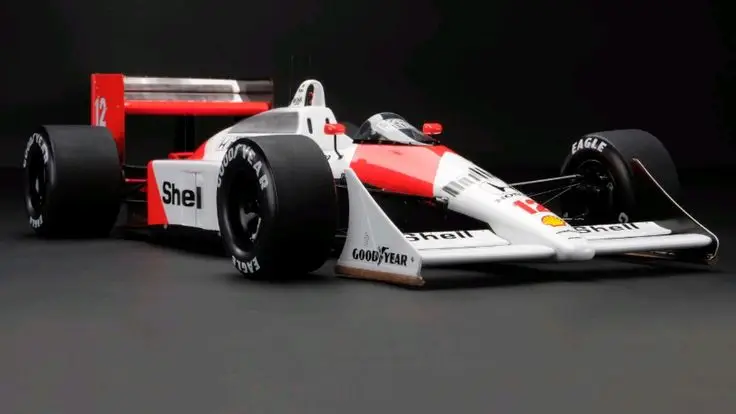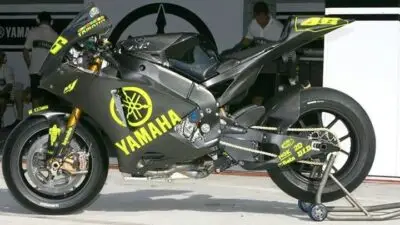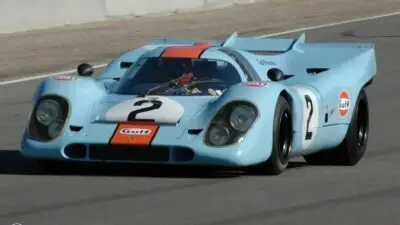The McLaren MP4/4 dominated the 1988 Formula 1 season like no car before or since, winning 15 out of 16 races and achieving an incredible 93.8% win rate. This Honda-powered machine represents the peak of Formula 1 engineering excellence during the turbocharged era.
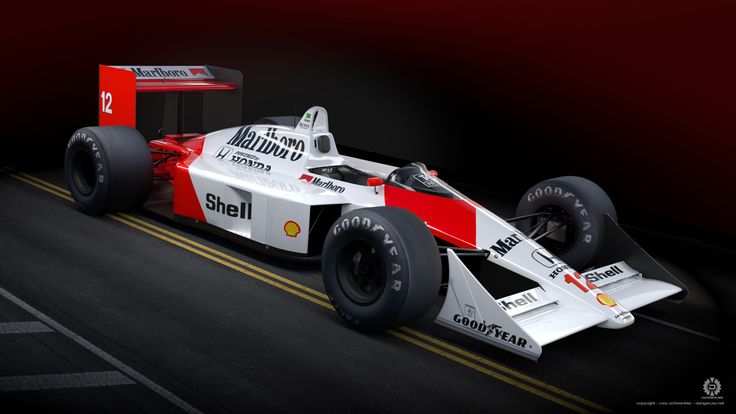
The MP4/4 stands as one of the most successful Formula One car designs of all time, combining revolutionary engineering with the legendary driving talents of Ayrton Senna and Alain Prost. The car’s success stemmed from perfect timing, innovative design, and exceptional teamwork between McLaren and Honda.
Understanding what made this machine so special reveals the complex world of Formula 1 engineering at its finest. The story involves groundbreaking technical innovations, fierce competition between teammates, and design decisions that influenced racing for decades to come.
Key Takeaways
- The McLaren MP4/4 achieved an unmatched 93.8% win rate in 1988 by winning 15 of 16 races
- Honda’s turbocharged V6 engine and McLaren’s innovative chassis design created the perfect engineering combination
- The car’s legacy continues to influence modern Formula 1 design and remains a benchmark for racing dominance
The Significance of the McLaren MP4/4 in Formula 1

The McLaren MP4/4 stands as Formula 1’s most dominant car with an unmatched 93.8% win ratio. The car revolutionized racing by winning 15 out of 16 races and securing both championship titles for McLaren.
Dominance in the 1988 F1 Season
The McLaren MP4/4 dominated the 1988 Formula 1 season in ways never seen before or since. The car won 15 out of 16 races during the season.
Ayrton Senna and Alain Prost drove the MP4/4 to incredible success. The team also claimed 15 pole positions throughout the season.
The car’s dominance extended beyond just wins. The MP4/4 led 1003 out of the 1078 laps raced that season.
This level of control meant McLaren was in front for over 93% of all racing laps. No other F1 car has matched this record.
The only race the MP4/4 lost was the Italian Grand Prix. Ferrari‘s Gerhard Berger won that single race at Monza.
Impact on World Championship Standings
McLaren secured both the Constructors’ and Drivers’ Championships with the MP4/4. The team finished the season with 199 points in the constructors’ standings.
Ayrton Senna won his first World Championship driving the MP4/4. He scored 90 points during the 1988 season.
Alain Prost finished second in the drivers’ championship with 87 points. Both McLaren drivers scored significantly more points than any competitor.
The point gap between McLaren and second place was massive. Ferrari finished second in the constructors’ championship with just 65 points.
This 134-point margin remains one of the largest in F1 history. The MP4/4’s success gave McLaren total control of both championship races.
Comparison to Rivals Like Ferrari
Ferrari struggled to compete with the MP4/4’s advanced design and Honda engine power. The Italian team managed only one victory during the 1988 season.
Key Performance Comparison:
- McLaren MP4/4: 15 wins, 15 poles, 199 points
- Ferrari F1-87/88C: 1 win, 1 pole, 65 points
Later dominant cars like Ferrari’s F2002 and Mercedes’ 2016 W07 could not match the MP4/4’s win percentage. The McLaren’s 93.8% success rate remained unbeaten.
Williams and Lotus also failed to challenge McLaren consistently. The MP4/4’s combination of Honda’s turbo engine and advanced aerodynamics left competitors behind.
Ferrari’s single win at Monza came only due to McLaren’s rare mechanical problems. Without those issues, the MP4/4 would have achieved a perfect season.
Key Designers and Contributors
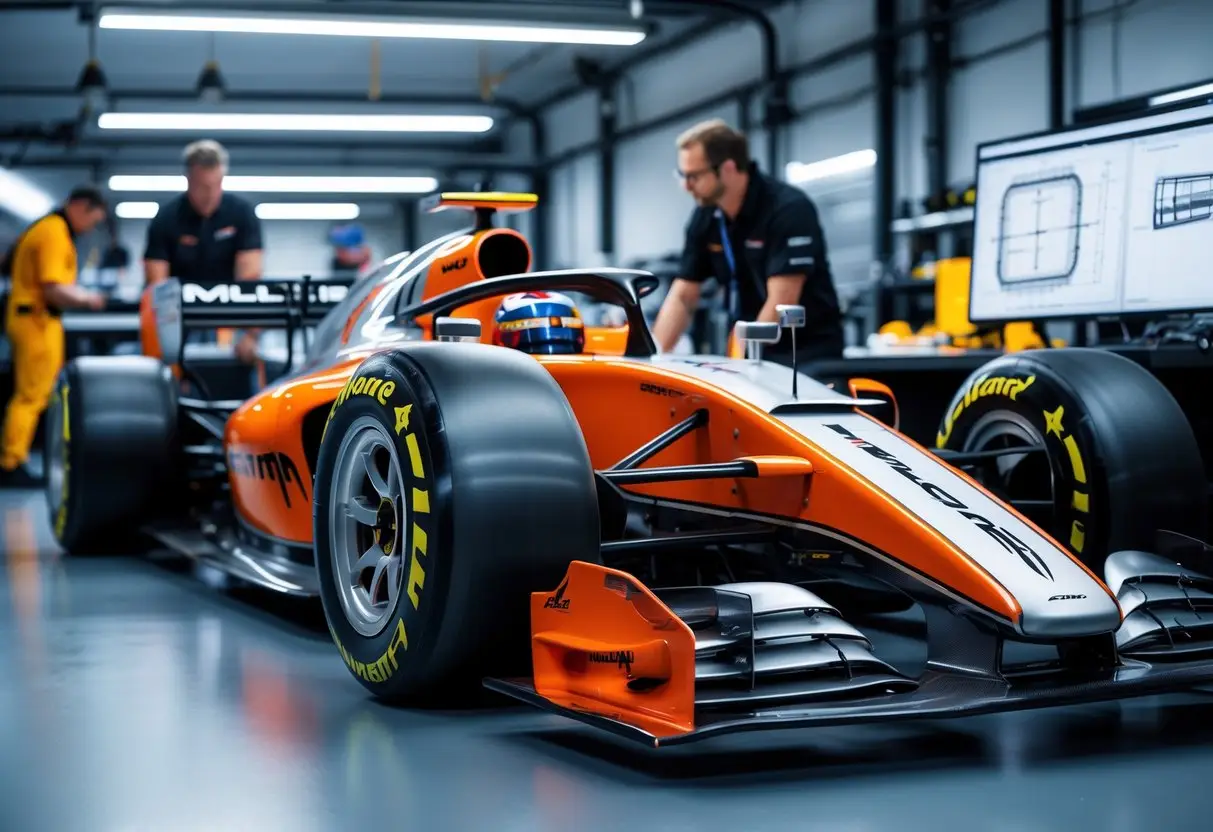
The MP4/4’s success came from a talented team of engineers and designers who each brought unique expertise to the project. Steve Nichols led the design work while drawing from Gordon Murray’s previous innovations and collaborating with other key McLaren personnel.
Role of Steve Nichols and the Design Team
Steve Nichols served as the primary designer of the MP4/4, taking the lead role in creating what would become F1’s most dominant car. The American engineer was tasked with the complete design responsibility for the 1988 season.
Nichols worked closely with McLaren’s engineering team to optimize every aspect of the car’s performance. His approach focused on creating a perfectly balanced machine that could maximize the Honda engine’s power advantage.
The design team under Nichols’ leadership paid careful attention to aerodynamics and weight distribution. They created a car that was both fast in straight lines and agile through corners.
Key Design Elements:
- Refined aerodynamic package
- Optimized chassis balance
- Enhanced cooling systems
- Improved driver ergonomics
Influence of Gordon Murray and Brabham BT55
Gordon Murray played a crucial supporting role in the MP4/4’s development, bringing his extensive F1 design experience to the project. His previous work on innovative car designs influenced the team’s approach.
Murray’s experience with the Brabham BT55 provided valuable lessons for the McLaren project. The BT55 had been an ambitious but flawed design that taught important lessons about low-profile car concepts.
The collaboration between Murray and Nichols combined fresh ideas with proven engineering principles. Murray’s guidance helped avoid potential pitfalls while encouraging innovative solutions.
This partnership created a knowledge transfer that strengthened the overall design process.
Contributions from Matthew Jeffreys
Matthew Jeffreys contributed to the MP4/4’s development as part of McLaren’s engineering team during this period. His work focused on specific technical aspects that supported the overall design goals.
Jeffreys brought expertise in areas that complemented the primary design work. His contributions helped refine details that were crucial for the car’s performance advantage.
The collaborative environment at McLaren allowed engineers like Jeffreys to make meaningful contributions to the project. Each team member’s expertise added to the car’s final success.
Legacy of John Barnard
John Barnard’s earlier innovations at McLaren laid the groundwork for the MP4/4’s success. His development of the carbon fiber monocoque in previous McLaren cars directly benefited the 1988 design.
Barnard had left McLaren before the MP4/4’s development, but his engineering philosophy remained influential. The structural advances he pioneered became standard features that Nichols’ team built upon.
Barnard’s Key Innovations:
- Carbon fiber chassis construction
- Advanced composite materials
- Improved safety structures
- Weight reduction techniques
The MP4/4 represented the evolution of Barnard’s original concepts into a refined racing machine.
Engineering Innovations and Design Philosophy
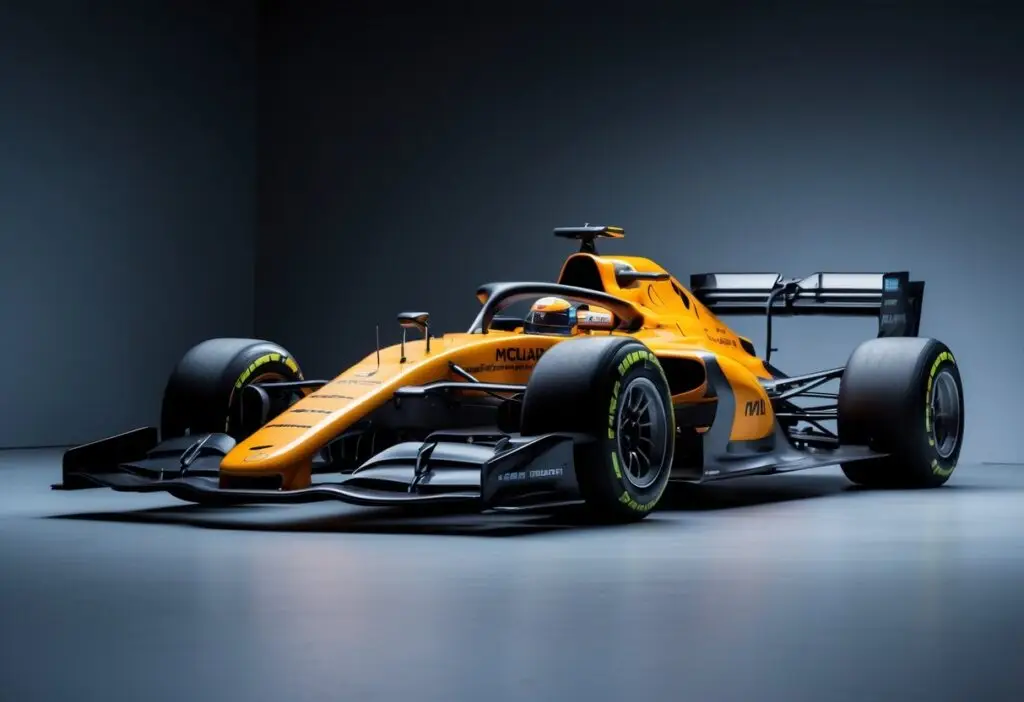
The MP4/4 represented a radical shift in Formula 1 engineering through its advanced carbon fiber construction, refined aerodynamic package, and compact mechanical layout. These innovations created the foundation for what many consider the most dominant Formula 1 car ever built.
Chassis and Monocoque Evolution
McLaren made significant advances in carbon fiber technology with the MP4/4’s monocoque design. The chassis used improved carbon fiber layup techniques that created a lighter yet stronger structure than the previous MP4/3.
Key Structural Improvements:
- Weight reduction: 15-20% lighter than MP4/3 chassis
- Torsional rigidity: 25% increase in structural stiffness
- Safety features: Enhanced driver protection zones
The team worked with specialized composite manufacturers to develop new carbon fiber weaving patterns. These patterns distributed stress more evenly across the chassis during impacts and cornering loads.
The monocoque featured revised mounting points for suspension components. Engineers positioned these mounts to optimize weight distribution and improve handling characteristics over the MP4/3 design.
Ground Effect and Aerodynamics
The 1988 season marked the final year of ground effect aerodynamics in Formula 1. McLaren maximized this technology with carefully sculpted underbody surfaces that created powerful downforce.
The MP4/4’s floor design generated approximately 40% of total downforce through ground effect principles. Air accelerated under the car created low pressure zones that pulled the vehicle toward the track surface.
Aerodynamic Package Features:
- Low-drag body shape optimized for high-speed circuits
- Refined sidepod inlets for improved cooling airflow
- Adjustable rear wing elements for different track configurations
Engineers balanced drag reduction with downforce generation across various circuit types. The car’s aerodynamic efficiency allowed competitive lap times on both high-speed ovals and technical road courses.
Mechanical Layout and Packaging
The Honda RA168E V6 turbo engine required careful integration into the MP4/4’s compact design. Engineers positioned the powerplant low in the chassis to lower the center of gravity and improve handling balance.
Fuel tank placement received particular attention due to the 150-liter fuel limit regulations. The main tank sat behind the driver with smaller collector tanks positioned for optimal weight distribution during races.
Packaging Innovations:
- Gearbox: Integrated transaxle design reduced overall length
- Cooling systems: Compact radiator arrangement improved airflow
- Electronics: Centralized control units minimized wiring complexity
The suspension geometry used pullrod actuated springs and dampers at both ends. This configuration kept suspension components within the aerodynamic envelope while maintaining precise wheel control.
Performance and Technical Specifications

The MP4/4’s dominance came from its advanced Honda turbo engine, refined suspension geometry, and exceptional reliability that allowed it to win 15 of 16 races in 1988. These technical achievements created a machine that combined raw power with precise handling and consistent performance.
Engine and Powertrain Integration
The MP4/4 used Honda’s RA168E engine, a 1.5-liter V6 turbocharged powerplant. This engine produced approximately 685 horsepower in qualifying trim and around 620 horsepower during races.
The turbo engine featured advanced fuel injection systems. Honda engineers optimized the engine mapping to deliver smooth power delivery across the rev range.
Key Engine Specifications:
- Displacement: 1.5 liters
- Configuration: V6 with twin turbochargers
- Power Output: 620-685 hp
- Fuel System: Electronic injection
The engine placement sat low in the chassis. This design lowered the car’s center of gravity and improved handling balance.
Honda’s reliability improvements reduced engine failures compared to previous seasons. The partnership between McLaren and Honda created seamless integration between chassis and powertrain systems.
Suspension and Handling
The MP4/4 featured a double wishbone suspension setup at both front and rear. This configuration provided precise wheel control and consistent tire contact with the track surface.
McLaren engineers tuned the suspension geometry for optimal aerodynamic performance. The ultra-low design required careful suspension packaging to maintain proper wheel travel.
Suspension Features:
- Front and rear double wishbones
- Adjustable anti-roll bars
- Precision-tuned dampers
- Low ride height capability
The car’s handling characteristics allowed drivers to push hard through corners. Both Ayrton Senna and Alain Prost praised the MP4/4’s predictable behavior at the limit.
Weight distribution favored slight rear bias. This setup helped with traction out of slow corners while maintaining front-end grip for turn-in.
Reliability and Efficiency
The MP4/4’s reliability record was exceptional for a turbocharged Formula 1 car. Both cars finished 13 of the 16 races, with mechanical failures being rare.
Honda’s engine development focused on durability without sacrificing performance. The RA168E engine could complete full race distances at maximum output.
Reliability Statistics:
- Race Finishes: 13 out of 16 possible
- Mechanical DNFs: Only 3 all season
- Points Scored: 199 out of possible 240
Fuel efficiency improvements allowed the MP4/4 to run lighter fuel loads. This weight advantage translated into faster lap times throughout race stints.
The car’s aerodynamic efficiency reduced drag while maintaining downforce. This balance helped achieve both straight-line speed and cornering performance without compromise.
Driver Achievements and Team Dynamics
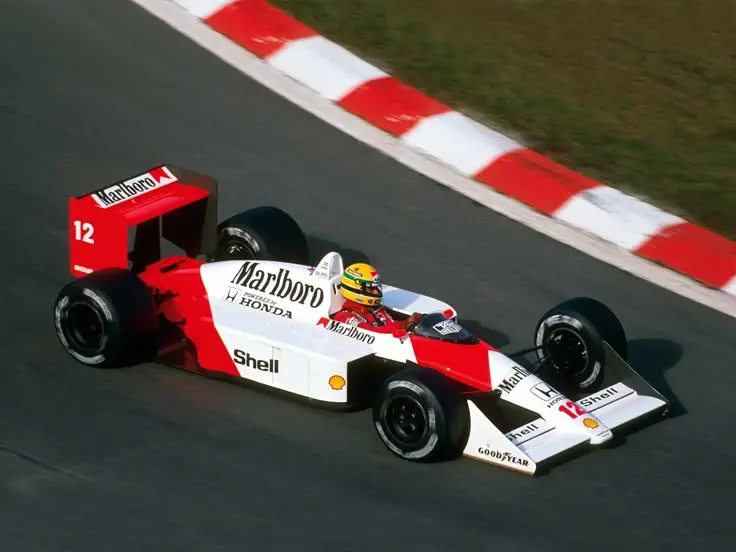
The McLaren MP4/4’s dominance came from having two world-class drivers who combined to win 15 out of 16 races in 1988. Ayrton Senna claimed his first championship while Alain Prost provided consistent speed and technical feedback.
Ayrton Senna’s Legendary Season
Senna secured his first Formula 1 World Championship in 1988 with eight race victories. He dominated qualifying sessions throughout the season with his aggressive driving style.
The Brazilian driver showed exceptional wet weather skills. His pole position performances became legendary during this campaign.
Senna’s championship fight against his teammate created intense competition within McLaren. He finished the season with 90 points compared to Prost’s 87 points.
Key Statistics:
- Race wins: 8
- Pole positions: 13 out of 16 races
- Championship points: 90
- Podium finishes: 13
Alain Prost’s Contribution
Prost won seven races during the 1988 season while driving the MP4/4. The French driver brought technical expertise and smooth driving techniques to the team.
His feedback helped McLaren engineers fine-tune the car’s setup. Prost’s consistent point-scoring kept both championships secure for McLaren.
The two-time world champion’s experience proved valuable in car development. He understood how to extract maximum performance from the Honda-powered machine.
Prost’s racing intelligence complemented Senna’s raw speed perfectly. Together, they formed one of the strongest driver partnerships in F1 history.
Senna vs Prost: Rivalry and Results
The Senna and Prost partnership delivered McLaren’s most successful season ever. Their rivalry pushed both drivers to perform at their peak level.
1988 Season Results:
| Driver | Wins | Podiums | Points | Championship Position |
|---|---|---|---|---|
| Ayrton Senna | 8 | 13 | 90 | 1st |
| Alain Prost | 7 | 13 | 87 | 2nd |
Their competition created tension within the team but maximized results on track. Both drivers finished on the podium in 13 out of 16 races.
The only race neither driver won was the Italian Grand Prix. Ferrari’s Gerhard Berger broke McLaren’s winning streak at Monza.
This partnership established the foundation for McLaren’s continued success. Their combined efforts made the MP4/4 the most successful F1 car in terms of win percentage.
Legacy and Lasting Influence

The McLaren MP4/4’s unparalleled success changed Formula 1 forever through its innovative engineering solutions and complete season dominance. This legendary machine became the benchmark that all future F1 designs would measure themselves against.
Influence on Future F1 Designs
The MP4/4 introduced several engineering concepts that became standard in modern Formula 1 cars. Its aerodynamic package and chassis design principles influenced car development for decades.
Key Design Elements Adopted by Later Cars:
- Advanced carbon fiber monocoque construction techniques
- Integrated aerodynamic philosophy balancing downforce and drag
- Sophisticated suspension geometry concepts
- Optimal weight distribution methods
The car’s suspension design borrowed from previous Brabham work became a template for future McLaren designs. Teams studied its aerodynamic efficiency to understand how to maximize performance within technical regulations.
Ferrari’s F2002 and Mercedes’ 2016 W07 both drew inspiration from the MP4/4’s design philosophy. However, neither achieved the MP4/4’s legendary 93.8% win ratio during their respective campaigns.
Recognition as a Motorsport Icon
The McLaren MP4/4 earned recognition as F1’s most dominant car through its record-breaking 1988 season performance. Racing historians consistently rank it among the greatest Formula 1 machines ever built.
Recognition Highlights:
- Won 15 out of 16 races in 1988
- Secured both drivers’ and constructors’ championships
- Featured in multiple F1 documentaries and retrospectives
The car’s legacy extends beyond pure statistics. F1 TV created a documentary exploring how it redefined dominance in motorsport.
Modern F1 fans and engineers still reference the MP4/4 when discussing peak performance. Its combination of technical excellence and competitive success created a standard that remains unmatched in Formula 1 history.
Frequently Asked Questions

The McLaren MP4/4‘s technical innovations and performance specifications continue to generate questions from racing enthusiasts and engineers alike. These common inquiries focus on the car’s groundbreaking technology, powerful Honda engine, and lasting impact on Formula 1 design.
What technological advancements set the 1988 McLaren MP4/4 apart in Formula 1 racing?
The MP4/4 combined the best of everything to create an unbeatable machine. Designers Steve Nichols and Gordon Murray created a car with superior aerodynamics and chassis balance.
The car featured advanced carbon fiber construction. This made it both lightweight and extremely strong.
The MP4/4 used sophisticated suspension systems that provided better handling. The aerodynamic package generated more downforce than competing cars.
Electronic systems helped drivers manage the car’s power delivery. These technologies worked together to create a complete racing package.
How did the McLaren MP4/4’s engine contribute to its dominance in the 1988 season?
The Honda RA168E 1.5-liter V6 turbo engine powered the MP4/4 throughout the 1988 season. This engine delivered exceptional power and reliability.
Honda’s turbo technology provided strong acceleration and top speed. The engine maintained consistent performance across different racing conditions.
Fuel efficiency allowed the car to run lighter fuel loads during races. This gave the MP4/4 a weight advantage over competitors.
The Honda engine rarely failed during the season. This reliability helped the team win 15 out of 16 races.
In what ways did the McLaren MP4/4 influence the design of its successors, such as the MP4/5 and MP4/6?
The MP4/4’s aerodynamic principles carried forward to later McLaren designs. The carbon fiber construction methods became standard practice.
Suspension geometry from the MP4/4 influenced the MP4/5’s handling characteristics. The weight distribution concepts continued in subsequent cars.
Electronic systems first perfected on the MP4/4 evolved in later models. The packaging solutions for engine and gearbox integration became templates.
McLaren’s design team used the MP4/4’s successful formula as a foundation. They adapted these proven concepts to new technical regulations.
What are the key specifications that made the McLaren MP4/4 a highly successful racing car?
The car used a 1.5-liter Honda turbo V6 engine mounted behind the driver. The carbon fiber monocoque chassis provided structural strength.
Total weight met the minimum Formula 1 requirements of the era. The wheelbase and track width optimized handling balance.
Six-speed manual transmission delivered power to the rear wheels. Advanced aerodynamics generated significant downforce.
The fuel tank capacity allowed for strategic race planning. These specifications combined to create F1’s most dominant car.
How did the design philosophy of the McLaren MP4/4 differ from that of the MP4/2?
The MP4/4 focused on complete aerodynamic integration rather than raw power. The MP4/2 relied more heavily on turbo boost and engine output.
Chassis design on the MP4/4 emphasized balance and driver confidence. The MP4/2 prioritized straight-line speed over cornering ability.
The MP4/4 used more sophisticated electronic systems for engine management. The MP4/2 had simpler controls and fewer driver aids.
Weight distribution changed between the two cars to improve handling. The MP4/4’s design philosophy emphasized consistency over peak performance.
What was the recorded horsepower of the McLaren MP4/4, and how did it impact its performance on the track?
The Honda RA168E engine produced approximately 675 horsepower in race trim. Qualifying configuration could generate over 700 horsepower.
This power level provided excellent acceleration from slow corners. Top speeds remained competitive on high-speed circuits like Monza.
The engine’s power delivery was smooth and predictable for drivers. This allowed Ayrton Senna and Alain Prost to push the car to its limits.
Power-to-weight ratio gave the MP4/4 superior performance across different track types. The horsepower helped the car lead 1003 out of 1078 laps during the 1988 season.
